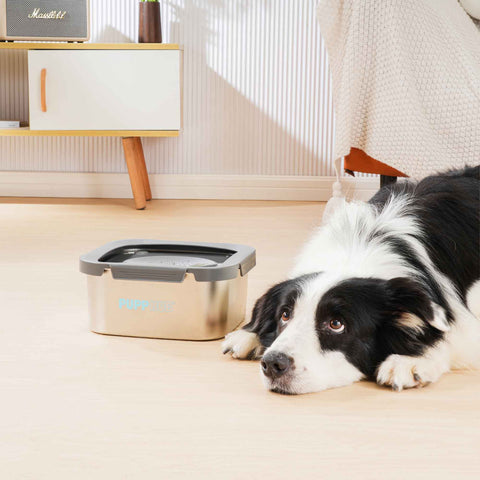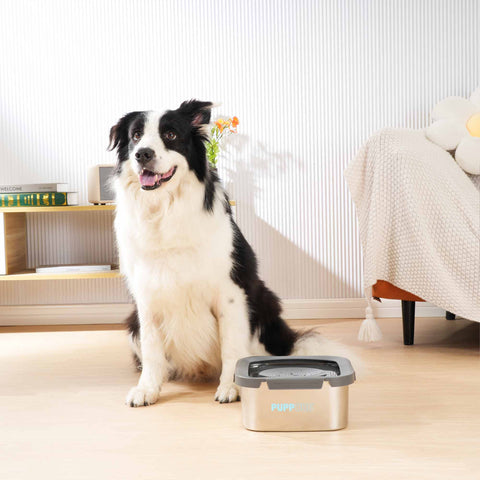Have you ever noticed your furry friend devouring their food in a matter of seconds? While it might seem harmless, it could lead to various health issues. This is where slow feeder dog bowls come into play. These specialized feeding dishes are designed with obstacles or unique structures-such as ridges, mazes, or patterns-that force dogs to navigate around them to access their food and are very unlike traditional bowls allowing for easy access.
To help better understand this kind of bowl, the blog will explore how slow feeder dog bowls function, the reasons behind fast eating behaviors, the benefits offered by slow feeder bowls, and so on.
How Does the Slow Feeder Work?
The mechanics of a slow feeder dog bowl are quite straightforward yet highly effective. The design incorporates raised areas or dividers that create barriers between the dog's mouth and the food.
Typically, these bowls feature complex obstacles such as bumps, grooves, and mazes. When a dog tries to eat from a slow feeder, they must maneuver around these obstacles, which forces them to take smaller bites and chew their food more thoroughly. This process not only slows down their eating pace but also engages them in a more mindful eating experience.
For those dogs that tend to have an insatiable appetite and habitually eat too quickly, slow feeders can be particularly beneficial. They help prevent various health problems associated with fast eating, such as bloat, indigestion, obesity, and gastric dilatation (a serious condition where the stomach twists).
Why Does My Dog Eat So Fast? 4 Reasons
So, what are the reasons that some dogs eat too quickly? You may wonder. Several key contributors to this behavior include:
1. Competition with Other Pets
It's possible that your dog is embracing their wolf ancestry and their natural appetite. Food was a limited supply in the wild, so dogs had to eat quickly to keep up with their rivals. In a similar vein, if you have several dogs, some may view other dogs as possible threats to their food, therefore they will eat quickly to make sure they finish their part before someone else does.
2. Breed Tendencies
Some dog breeds are inherently more likely than others to eat quickly due to their physical traits and instincts. For instance, large breeds like Labradors and Greyhounds are notorious for gulping down their food at a rapid pace. This may be a holdover from their history as working or hunting dogs, when they had to eat quickly in order to survive.
3. Scent Over Taste
Dogs have far fewer taste buds than we do-about 1,700 compared to our roughly 9,000. Because of this, they don't experience flavors the same way we do, which can make them less picky about what they eat. Many dogs will happily gobble up whatever food is in front of them, especially when they're excited for mealtime.
While dogs don't take the time to enjoy their meals like humans might, they have an amazing sense of smell that really drives their eating habits. When they catch a whiff of food that smells good to them, they tend to dive right in and eat quickly. For them, the main goal is to fill their bellies rather than savor each bite.

4. A Health-Related Issue
Eating too rapidly could occasionally indicate a health issue in your dog. Dogs who are uncomfortable, tense, or anxious may eat quickly to help them cope. They may also eat quickly due to gastric reflux or other stomach problems in an instinctive attempt to feel better. It's critical to send your dog to the doctor if you observe them eating rapidly on a regular basis and exhibiting symptoms of distress, such as excessive drooling, vomiting, or behavioral changes.
What Are the Health Risks of Fast Eating in Dogs? 3 Risks
No matter the reason your dog is eating too quickly, this behavior can result in several serious health issues:
1. Bloat (Gastric Dilatation-Volvulus)
One of the most dangerous issues that can arise from a dog eating too quickly is bloat. It happens when gas builds up in a dog's stomach and twists, potentially posing a serious risk to their lives.
Large breeds are particularly prone to bloat, so it's critical for owners to monitor their feeding patterns. Your dog may be experiencing bloat if they have a swollen belly, restlessness, excessive drooling, and unsuccessful attempts to throw up. See a veterinarian straight away if you suspect your dog is suffering from bloat.
2. Digestive Problems
Eating too fast can cause several digestive issues, like indigestion, gas, and vomiting. When dogs gulp down their food, they often swallow air at the same time, which can lead to discomfort and bloating. Also, if they don't chew their food well, it makes digestion harder for them. This can lead to more stomach problems that might affect your dog's overall health.3. Weight Gain
Dogs that eat quickly might not be able to recognize when they are full, which could cause them to overeat. This can eventually lead to obesity, which brings its own set of health risks, such as diabetes, heart disease, and joint issues.
4 Benefits of Using Slow Feeder Dog Bowls
1. Prevents Bloat and Promotes Better Digestion
Through slowing down the eating pace, these bowls prevent excessive air intake and the potential twisting of the stomach. Dogs who eat more slowly are able to properly chew their food, which facilitates better digestion. Less stomach problems like gas, bloating, or vomiting may result with this.
2. Aids in the Weight Control
Dogs who eat more slowly may feel fuller sooner and use less food overall. For dogs who need to maintain a healthy weight or shed weight, this can be extremely helpful as it helps foster a healthier relationship with food.
3. Encourages Mindfulness and Adds Fun
Slow feeder bowls do more than just slow down your dog's eating; they also challenge their minds. With their maze-like designs, these bowls make dogs work for their food, giving them mental exercise that makes mealtime more fun and interesting. This added stimulation helps keep your dog engaged and turns feeding time into an enjoyable experience rather than just a quick bite.
4. Reduces Anxiety
Those who eat quickly may occasionally feel anxious about eating because they think they must finish soon to prevent competing with other pets. Using a slow feeder can help reduce stress at mealtimes by fostering a calmer feeding environment.

What Is the Best Type of Slow Feeder Dog Bowl?
You can choose from a variety of materials and patterns for your slow feeder dog bowl. Here is a comparison table that highlights the qualities of common materials, like silicone, plastic, ceramic, and stainless steel, to help you make an informed choice.
|
Feature |
Plastic |
Ceramic |
Stainless Steel |
Silicone |
|---|---|---|---|---|
|
Weight |
Lightweight |
Heavy |
Moderate to Heavy |
Lightweight |
|
Durability |
Moderate |
Moderate |
Very high |
High |
|
Ease of Cleaning |
Easy to clean |
Dishwasher-safe (some) |
Very easy to clean (dishwasher-safe) |
Easy to clean |
|
Price Range |
$10 - $25 |
$15 - $35 |
$20 - $50 |
$15 - $30 |
|
Design Variety |
Many shapes and colors |
Aesthetically pleasing |
Simple designs |
Fun and colorful designs available |
|
Odor Retention |
May retain odors |
Does not retain odors |
Does not retain odors |
Does not retain odors |
|
Best For |
Budget-conscious pet owners |
Stable for enthusiastic eaters |
Long-lasting and easy maintenance |
Non-slip options for messy eaters |
Get a Slow Feeder Dog Bowl Today!
If you have a fast eater at home, think about getting a slow feeder bowl. It promotes better feeding habits and keeps your dog happy and cognitively stimulated. You can lower your dog's risk of health problems and improve mealtime enjoyment by slowing down their feeding pace. Don't wait-make mealtime a fun and healthy experience for your furry friend today!
